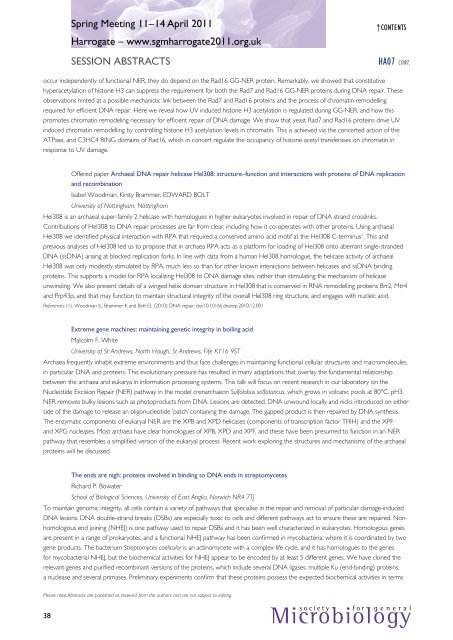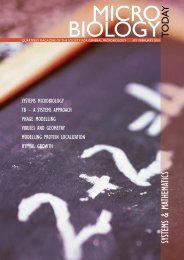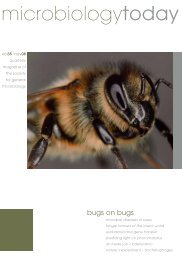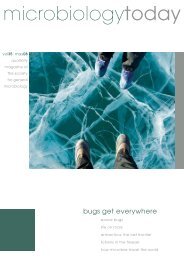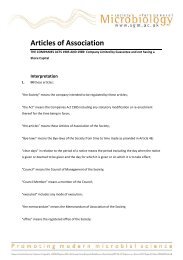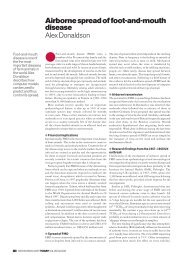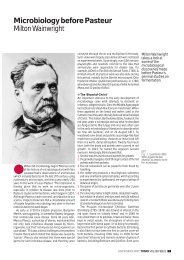Spring Conference 2011 - Society for General Microbiology
Spring Conference 2011 - Society for General Microbiology
Spring Conference 2011 - Society for General Microbiology
You also want an ePaper? Increase the reach of your titles
YUMPU automatically turns print PDFs into web optimized ePapers that Google loves.
Please note: Abstracts are published as received from the authors and are not subject to editing.<br />
38<br />
<strong>Spring</strong> Meeting 11–14 April <strong>2011</strong><br />
Harrogate – www.sgmharrogate<strong>2011</strong>.org.uk<br />
SESSION AbSTrACTS<br />
↑Contents<br />
HA07 Cont.<br />
occur independently of functional NEr, they do depend on the rad16 GG-NEr protein. remarkably, we showed that constitutive<br />
hyperacetylation of histone H3 can suppress the requirement <strong>for</strong> both the rad7 and rad16 GG-NEr proteins during DNA repair. These<br />
observations hinted at a possible mechanistic link between the rad7 and rad16 proteins and the process of chromatin remodelling<br />
required <strong>for</strong> efficient DNA repair. Here we reveal how uV induced histone H3 acetylation is regulated during GG-NEr, and how this<br />
promotes chromatin remodeling necessary <strong>for</strong> efficient repair of DNA damage. We show that yeast rad7 and rad16 proteins drive uV<br />
induced chromatin remodelling by controlling histone H3 acetylation levels in chromatin. This is achieved via the concerted action of the<br />
ATPase, and C3HC4 riNG domains of rad16, which in concert regulate the occupancy of histone acetyl transferases on chromatin in<br />
response to uV damage.<br />
Offered paper Archaeal DNA repair helicase Hel308: structure–function and interactions with proteins of DNA replication<br />
and recombination<br />
isabel Woodman, Kirsty Brammer, EDWArD BOlT<br />
University of Nottingham, Nottingham<br />
Hel308 is an archaeal super-family 2 helicase with homologues in higher eukaryotes involved in repair of DNA strand crosslinks.<br />
Contributions of Hel308 to DNA repair processes are far from clear, including how it co-operates with other proteins. using archaeal<br />
Hel308 we identified physical interaction with rPA that required a conserved amino acid motif at the Hel308 C-terminus1 . This and<br />
previous analyses of Hel308 led us to propose that in archaea rPA acts as a plat<strong>for</strong>m <strong>for</strong> loading of Hel308 onto aberrant single-stranded<br />
DNA (ssDNA) arising at blocked replication <strong>for</strong>ks. in line with data from a human Hel308 homologue, the helicase activity of archaeal<br />
Hel308 was only modestly stimulated by rPA, much less so than <strong>for</strong> other known interactions between helicases and ssDNA binding<br />
proteins. This supports a model <strong>for</strong> rPA localizing Hel308 to DNA damage sites, rather than stimulating the mechanism of helicase<br />
unwinding. We also present details of a winged helix domain structure in Hel308 that is conserved in rNA remodelling proteins Brr2, Mtr4<br />
and Prp43p, and that may function to maintain structural integrity of the overall Hel308 ring structure, and engages with nucleic acid.<br />
References: (1). Woodman il, Brammer K and Bolt El (2010) DNA repair. doi:10.1016/j.dnarep.2010.12.001<br />
Extreme gene machines: maintaining genetic integrity in boiling acid<br />
Malcolm F. White<br />
University of St Andrews, North Haugh, St Andrews, Fife KY16 9ST<br />
Archaea frequently inhabit extreme environments and thus face challenges in maintaining functional cellular structures and macromolecules,<br />
in particular DNA and proteins. This evolutionary pressure has resulted in many adaptations that overlay the fundamental relationship<br />
between the archaea and eukarya in in<strong>for</strong>mation processing systems. This talk will focus on recent research in our laboratory on the<br />
Nucleotide Excision repair (NEr) pathway in the model crenarchaeon Sulfolobus solfataricus, which grows in volcanic pools at 80°C, pH3.<br />
NEr removes bulky lesions such as photoproducts from DNA. lesions are detected, DNA unwound locally and nicks introduced on either<br />
side of the damage to release an oligonucleotide ‘patch’ containing the damage. The gapped product is then repaired by DNA synthesis.<br />
The enzymatic components of eukaryal NEr are the xPB and xPD helicases (components of transcription factor TFiiH) and the xPF<br />
and xPG nucleases. Most archaea have clear homologues of xPB, xPD and xPF, and these have been presumed to function in an NEr<br />
pathway that resembles a simplified version of the eukaryal process. recent work exploring the structures and mechanisms of the archaeal<br />
proteins will be discussed.<br />
The ends are nigh: proteins involved in binding to DNA ends in streptomycetes<br />
richard P. Bowater<br />
School of Biological Sciences, University of East Anglia, Norwich NR4 7TJ<br />
To maintain genomic integrity, all cells contain a variety of pathways that specialise in the repair and removal of particular damage-induced<br />
DNA lesions. DNA double-strand breaks (DSBs) are especially toxic to cells and different pathways act to ensure these are repaired. Nonhomologous<br />
end joining (NHEJ) is one pathway used to repair DSBs and it has been well characterized in eukaryotes. Homologous genes<br />
are present in a range of prokaryotes, and a functional NHEJ pathway has been confirmed in mycobacteria, where it is coordinated by two<br />
gene products. The bacterium Streptomyces coelicolor is an actinomycete with a complex life cycle, and it has homologues to the genes<br />
<strong>for</strong> mycobacterial NHEJ, but the biochemical activities <strong>for</strong> NHEJ appear to be encoded by at least 5 different genes. We have cloned the<br />
relevant genes and purified recombinant versions of the proteins, which include several DNA ligases, multiple Ku (end-binding) proteins,<br />
a nuclease and several primases. Preliminary experiments confirm that these proteins possess the expected biochemical activities in terms<br />
s o c i e t y f o r g e n e r a l<br />
<strong>Microbiology</strong>


